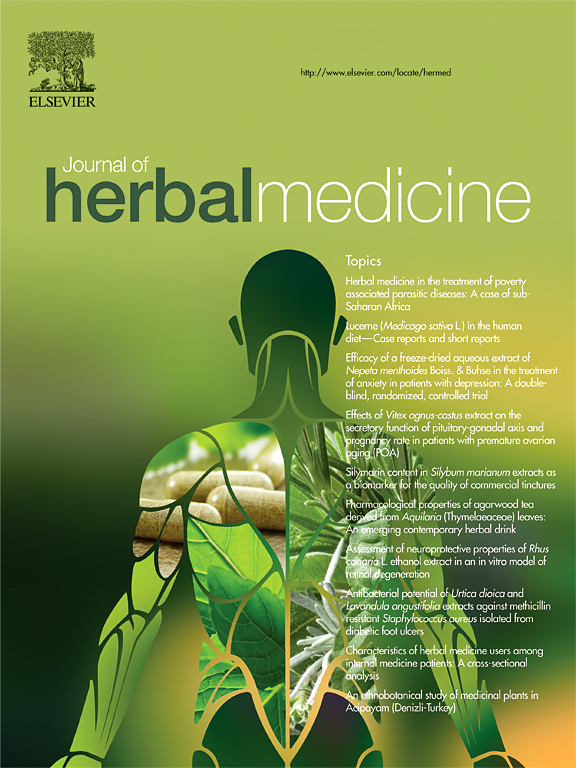Effectiveness and Safety of Blending Traditional Chinese Medicine With Western Medicine for Enhanced Secondary Stroke Prevention: A Meta-analysis of RCTs
IF 1.9
4区 医学
Q2 INTEGRATIVE & COMPLEMENTARY MEDICINE
引用次数: 0
Abstract
Introduction
To conduct a comprehensive evaluation of the efficacy and safety of combining traditional Chinese medication (TCM) with Western medication to improve secondary stroke prevention. Through meticulous analysis, we investigate the combined approach's potential to yield superior outcomes compared to stand-alone Western medical treatments.
Methods
We rigorously searched for RCTs on secondary stroke prevention using TCM and Western medicine (WM) from database creation to October 2023. PubMed, EMBASE, Cochrane Library, CNKI, SinoMed, WanFang, and VIP yielded pertinent studies. Stata 16.0 was used for comprehensive meta-analyses with predetermined inclusion and exclusion criteria.
Results
This thorough review comprised 40 randomised controlled trials with 3 478 treatment and 3 396 control participants. Combining TCM and WM significantly enhances secondary stroke prevention rates compared to WM alone (OR = 0.83, 95% CI: 0.55–1.12, P < 0.001). Compared to Western medical treatment for secondary stroke prevention, the integrated strategy significantly lowered the National Institutes of Health Stroke Scale score (OR = -0.62, 95% CI: -0.89, -0.35, P < 0.001). Furthermore, this integrated strategy effectively reduced stroke recurrence rates compared to Western medical therapy alone (OR = -0.94, 95% CI: -1.10, -0.76, P < 0.001). The rate of adverse reactions was not significantly different between Western medical treatment and integrated TCM (OR = 0.01, 95% CI: −0.18, 0.05, P = 0.131).
Conclusions
The evidence shows that combining TCM and Western therapy improves secondary stroke prevention. Besides improving clinical effectiveness, this integrated approach may reduce stroke recurrence. These findings strongly support the widespread use of this integrated approach in clinical practice.

中西医结合加强继发性脑卒中预防的有效性和安全性:一项随机对照试验的meta分析
目的:综合评价中西医结合预防脑卒中的疗效和安全性。通过细致的分析,我们调查了联合方法与单独西医治疗相比产生更好结果的潜力。方法从数据库创建至2023年10月,严格检索中西医结合预防脑卒中的rct。PubMed、EMBASE、Cochrane Library、CNKI、SinoMed、万方、VIP等均有相关研究。采用Stata 16.0进行综合荟萃分析,采用预先确定的纳入和排除标准。结果本综述包括40项随机对照试验,其中治疗组3 478例,对照组3 396例。与单用中西医结合治疗相比,中西医结合治疗可显著提高二次卒中预防率(OR = 0.83, 95% CI: 0.55-1.12, P <;0.001)。与西医二级卒中预防相比,综合策略显著降低了美国国立卫生研究院卒中量表评分(OR = -0.62, 95% CI: -0.89, -0.35, P <;0.001)。此外,与单纯西医治疗相比,该综合策略有效降低了卒中复发率(OR = -0.94, 95% CI: -1.10, -0.76, P <;0.001)。西药治疗与中西医结合治疗不良反应发生率差异无统计学意义(OR = 0.01, 95% CI:−0.18,0.05,P = 0.131)。结论中西医结合治疗可有效预防继发性脑卒中。除提高临床疗效外,还可减少脑卒中复发率。这些发现有力地支持了这种综合方法在临床实践中的广泛应用。
本文章由计算机程序翻译,如有差异,请以英文原文为准。
求助全文
约1分钟内获得全文
求助全文
来源期刊

Journal of Herbal Medicine
INTEGRATIVE & COMPLEMENTARY MEDICINE-
CiteScore
3.90
自引率
0.00%
发文量
94
期刊介绍:
The Journal of Herbal Medicine, the official journal of the National Institute of Medical Herbalists, is a peer reviewed journal which aims to serve its readers as an authoritative resource on the profession and practice of herbal medicine. The content areas of the journal reflect the interests of Medical Herbalists and other health professionals interested in the clinical and professional application of botanical medicines. The objective is to strengthen the research and educational base of herbal medicine with research papers in the form of case studies, original research articles and reviews, monographs, clinical trials and relevant in vitro studies. It also publishes policy statements, opinion pieces, book reviews, conference proceedings and profession related information such as pharmacovigilance reports providing an information source for not only the Herbal Practitioner but any Health professional with an interest in phytotherapy.
 求助内容:
求助内容: 应助结果提醒方式:
应助结果提醒方式:


